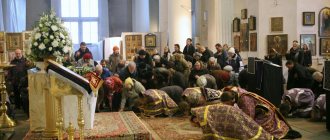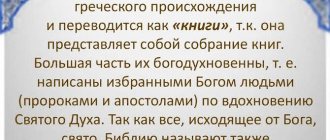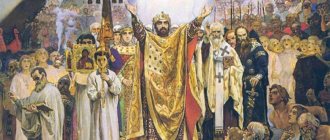Monasticism
The rite of tonsure into monasticism is truly a person’s mysterious entrance into the world of the highly spiritual order of angels, baptism in a certain sense. Tonsure or tonsure into monasticism is the mysterious introduction of a person under the yoke of Christ (see Matt. 11, 28, 29), similar to anointing.
In pre-Christian times, cutting hair was a symbol of slavery, or associated with suffering some kind of grief. tonsure has always been one of the main religious rites - a symbol of obedience and sacrifice[]. In our time, several ritual actions are associated with tonsure: 1. hair cutting is performed on a newly baptized person after baptism as a sign of service to Christ; 2. hair cutting is performed during initiation of a newly ordained reader as a sign of service to the Church; 3. tonsure performed upon becoming a monk.
Monastic tonsure corresponds to three degrees of monasticism. So, there is tonsure into the Rassophor, tonsure into the small schema and tonsure into the great schema[]. The main elements present during the rite of tonsure: the pronouncing of vows, the monastic robe and the actual cutting of the hair. Being tonsured into the ryassophore is not in itself, in the literal sense, the adoption of monasticism, because monastic vows are not taken. But at this tonsure, prayers are read over the tonsured person, and he is handed over to the confessor for life in the monastery. The tonsure into the mantle or minor schema currently includes, by default, the ryasophore. This tonsure contains both vows and a more solemn ceremony. The vows given when being tonsured into the mantle are the following: obedience, fasting, chastity, non-covetousness, reverence. The tonsure into the great schema follows the same rank as into the small one, but with much greater solemnity[].
Who invented church rituals
Legends say that most church and religious rituals were handed down to humanity from above, but in essence this is not the case. Not only in the Bible, but also in any other scripture there are no clear descriptions of certain actions that are pleasing to God. All rituals that exist in our time were invented by people or clergy. Moreover, the church created Orthodox rituals in order to gain greater power over the parishioners. However, all churches, communities and sects in the world strive to control people in this way. Many of the rituals and traditions developed over generations and over several hundred years became the foundations of religious life.
The fact that it was from tradition that some rituals were formed is evidenced by the fact that, despite a single religion, many, even neighboring regions, revere actions that are different from each other. Considering that they are the true bearers of culture and Orthodoxy.
In order to bring all believers as close as possible and reduce civil strife on religious grounds, the church came up with canons and common principles that have been revered for hundreds of years. Some holidays that were inherent in paganism were transferred to Orthodoxy. In particular, this is Maslenitsa, Apple Saved and others.
Burial and funeral service
Perhaps our faith is in vain if Jesus Christ is not resurrected (see 1 Cor. 15, 12, 13), if we do not expect life after death. We believe in life after death, in the life of the next century (Creed).
Through the sacraments we are reunited by the Church with God and the world. Through prayers for the departed, we can beg God and them (the deceased) to reunite with Himself.
A person’s body is the temple of his soul, and the body of a Christian is also the temple of the Holy Spirit living in him (see 1 Cor. 6:19). Therefore, the attitude towards the body in the Orthodox Church not only as a cell of the soul is similar to the attitude of the Epicureans. In his earthly life, a person resorts to various grace-filled sacraments of the Church, which sanctify not only his soul, but also his body. Both in the Old Testament and in the New Testament Church, the body of the deceased was treated with love and respect, since this corruptible must put on incorruption, and this mortal must put on immortality (1 Cor. 15:53). Therefore, his body was prepared for burial by certain actions. Such preparation includes: washing the body, dressing the deceased, positioning the body in the coffin, reading and singing funeral prayers[].
On the third day after death, a funeral service is performed over the body of the deceased. A funeral service is a funeral service for the dead. It is performed by a priest over a member of the Church who has passed away from temporary life. In this rite, the Church prays for the forgiveness of the deceased for all his lifetime sins.
The funeral service can be performed in a church or at home, where a priest is invited. During the funeral service, all those accompanying the deceased pray with lit candles, signifying the Non-Evening Light of eternity. When saying goodbye, the icon on the chest and the forehead (crown) of the deceased are kissed[].
Also in the Russian Orthodox Church there is a practice of funeral services in absentia, i.e. such a funeral service, which is performed by a priest without the body of the deceased. However, this practice, which came into general use during the days of the persecution of the Church due to the impossibility of performing funeral services using the traditional method, is derived from cases when the body of the deceased could not be found or in the event that the deceased was already buried, and the funeral service for some reason did not take place. Therefore, the funeral of the deceased in absentia in our time, with the exception of the cases described above, is unacceptable.
Church funeral services are not performed for persons of other faiths, unbaptized people, or suicides (except in cases of insanity).
In addition to the funeral service, on the third, ninth and fortieth days after a person’s death, a funeral service called a memorial service must be performed. Also, a memorial service is performed on the birthday of the deceased, on his name day and on the day of his death.
A memorial service is a service during which the deceased are remembered by name, asking God for forgiveness of sins, blessed eternal life and rest with the saints.
Rules for conducting rituals
Conducting any church rites in Orthodoxy requires the implementation of certain rules that were established centuries ago. Many rules and principles are not familiar to believers, and in order not to make mistakes and do everything properly, it is advisable to consult with a clergyman in the nearest church. He will tell you what is needed and the minimum set of rules that must be followed to carry out this or that ritual, and he will take into account all the features, because despite the unified Orthodox faith, each individual region has its own small nuances.
Ritual of exorcism in Orthodoxy
One of the important rites in Orthodoxy is exorcism or the expulsion of demons that have possessed righteous people. Not all priests are given the right to perform this ritual. It is generally accepted that the person performing this ritual must have real strength and a pure soul, otherwise he can harm himself and the people around him. Moreover, in the Orthodox Church there are two opinions, one of which says that expulsion, like repentance, should take place one-on-one with a priest, others allow for the mass expulsion of demons from parishioners. Despite the fact that the ritual is performed by a priest, the expulsion itself occurs by the will of God; the person who carries out the reprimand is simply a conductor of divine power.
Ritual of cleansing a house with a church candle
In addition to cleansing the soul and driving out demons, there is a ritual that allows you to cleanse the house of negativity with the help of a church candle. For this ritual it is not necessary to have a priest present and you can perform it yourself. Of the necessary items, you only need a church wax candle. It needs to be lit on the threshold and passed through all the rooms of the house. You need to walk along the walls clockwise, and in the places of doorways and corners of rooms, you should stay longer. It is these areas of living space that are the places where negativity and dark forces are concentrated. During the cleansing ritual, the candle may not burn evenly, it may smoke and the flame may crackle, but at the end of the ritual the candle should burn evenly. It is the calm flame that will indicate that the ritual is completed and the house is cleansed of all negativity. The candle stub is not thrown away, but is taken to the altar where it burns out in front of the saints. It is important to carry out this ritual believing in its power and the power of divine energy.
Prayer service
A prayer service, or prayer singing, is a special divine service in which the gracious help of the Lord Jesus Christ, the Blessed Virgin Mary, the Heavenly Powers or the saints of the Orthodox Church is asked. Prayer services serve not only to ask for help in various needs, but also to give thanks for the blessings of God received.
Prayer services are served not only in churches, but also in the homes of believers, on the streets, in the field (when there is no rain), in schools (at the beginning of school), etc.
Prayer services have always been served in Rus', and this was the natural desire of people to ask God for blessings in common prayer. Konstantin Paustovsky describes the following general prayer service in “The Tale of Forests”: “The next morning a priest came from Paramonov with a psalm-reader to serve a prayer service for the sending of rain. All the people with banners came out to a hillock among the fields - from that hillock in clear weather the right bank of the Volga was visible."
Currently, in many churches a prayer service is served every day after the Liturgy - the so-called rite of general prayer. Metropolitan Hilarion (Alfeev) notes: “The almost universal distribution of prayers in the Russian Church testifies to the development of liturgical piety towards semantic simplification with the replacement of more ancient, lengthy and complex texts with simpler, concise and accessible ones”[]. However, not only the ease of perception of prayers serves to spread them. This is also facilitated by directly voicing the requested things: if it is the beginning of the year - a prayer service with petitions for a favorable year; if there is a drought - a prayer service with requests for rain. And, undoubtedly, the desire of people to order a prayer service and come to pray at it grows from service to service.
Seven Sacraments of the Holy Orthodox Church
Later, one more, seventh, was added to the number of customs already described. The list of church Christian sacraments includes:
- Baptism. This is a sign of cleansing from sins. For him, a person is immersed in water three times. It is believed that after washing and making the sign of the cross, an Orthodox Christian comes out of the water cleansed of filth and can try to start life with a clean slate.
- Confirmation. This rite replaced the method of laying hands on the heads of believers by the bishop himself. Today a person is sanctified by anointing with myrrh.
- Eucharist or communion. With the help of this action, believers join the Lord. They eat bread, thereby commemorating the body of Christ, and drink wine, symbolizing his blood.
- Confession or repentance. In front of the priest, believers talk about their sins and ask for forgiveness from the Lord. The action is complicated by secret confession. This means that the one who accepts confession, no matter what rank he has, cannot tell someone else about the sin, even if we are talking about a crime against a person.
- Anointing. Oil is used for it. Most often, the blessing of oil is prepared for a sick person, for whom anointing with oil should bring tangible relief.
- Priesthood. This is a rite of passage.
- Wedding. A ritual designed to unite two people in sacred bonds: a man and a woman.
All of the above actions refer to a specific period. Each of the rituals is carried out only if several conditions are met. For example, confession precedes communion. And you can’t plan a wedding if you don’t confess and take communion first.
Particular importance is attached to the secret of confession. The tradition of repentance appeared in the church back in the days of early Christianity. At that time, many believed that confession should only take place once in a lifetime. They prepared specially for it, but most often they reserved confession for the last days of life.
Later, a special system was established: confession became regular and mandatory for many other sacraments.
Akathist
In many churches and monasteries in our time, prayer singing is performed with akathists joining them. This practice has become widespread only in the territory of the Russian Orthodox Church and only over the last one and a half to two centuries[].
Akathists are touching church works. The word “akathist” is of Greek origin and means “a hymn that one does not sit while singing,” in contrast to “kathisma.” The akathists are quite simple in content and are easily memorized by ear by believers. (For example, akathists to saints are compiled according to the principle of a brief transcription of the content of their lives). That is why the number of akathists has grown incredibly over the past decades. The total number of akathist texts is over 1200[].
There are akathists to the Savior, the Mother of God, the Guardian Angel, and any of the saints. In the statutes regulating the rule by which it is necessary to prepare for communion, there is an akathist (to the Sweetest Jesus or to the Mother of God). “The frequent repetition of the name Jesus and the name of the Mother of God introduces the reader into living communication and relationship with the Savior and the Mother of God”[].
Unction - what is it?
In order to prevent a possible mistake in understanding two sacred rites that have common features - the rite of anointing and the sacrament of unction - some clarification is required. The fact is that each of them uses consecrated oil - oil. But if in the first case the priest’s actions are purely symbolic, then in the second they are aimed at invoking God’s grace.
Accordingly, the sacrament of unction is a more complex sacred rite and is performed, according to church canons, by seven priests. Only in extreme cases is it allowed to be performed by one priest. Anointing with oil is performed seven times, while excerpts from the Gospel, chapters from the Epistle of the Apostles and special prayers intended for this occasion are read. At the same time, the church rite of anointing, as mentioned above, consists only in the fact that the priest, while blessing, applies oil with the sign of the cross on the forehead of the believer.
Blessing of water
Currently, the blessing of water is performed in all churches of the Russian Orthodox Church, and all believers have access to holy water. The consecration of water as a rite is of two types: the small consecration of water and the great. After the great consecration, we call the water the great agiasma, or the great shrine. Such consecration occurs only twice a year, on the feast of Epiphany (Epiphany) and on its eve. The blessing of water is performed on this day not only in churches, but also on rivers and reservoirs. If a priest or bishop on the feast of Epiphany goes to bless water in a natural open reservoir, then such consecration is called “going to the Jordan,” in honor of the Baptism of Jesus Christ in the Jordan River. In Rus', the consecration of water on the eve of the holiday took place in the temple, and on the holiday itself at the “Jordan”, i.e. in the ice hole, into which those who wished would plunge after completing the rite[].
The rite of small consecration of water is performed more often than the great one. The main days when water is blessed: on the Feast of the Origin of the Trees (August 1), on the holiday in honor of the icon of the Mother of God “Life-Giving Spring” (on Friday of Bright Week), on the eve of Pentecost, on the day of the patronal feast of the temple. However, in addition to those listed, water is sanctified at the request of believers on other days. Many churches have a tradition of blessing water every Sunday so that believers can always drink holy water.
Holy water is used by believers with reverence and prayer for the healing of soul and body[].
Christian sacraments
Sacraments are called such actions in Christianity, the purpose of which is to receive grace from God. The teaching about this is based on the Christian faith about the atonement of human sins by Jesus Christ. This sacrifice was begun by the Divine Son before his execution, but continues through the church to this day and will continue until the terrible day of judgment comes.
Church rituals and sacraments are different actions for Orthodoxy. The Church performs rituals according to the canons written after the death of Christ by his disciples. And the sacraments were established by Jesus himself to fill and change the inner and outer life of a person.
Orthodox and Catholics perform rituals differently. Dates and actions may differ, but the essence remains the same for all branches of Christianity.
Consecration of the temple
In Rus', in the place where people began to settle, the first thing they did was build a temple. The temple, like everything produced on earth for the salvation of believers, must be sanctified. After all, a temple is an “ordinary” building until the moment when the rite of consecration is performed over it. After the perfect rite, the temple acquires new qualities, because becomes the receptacle of the greatest shrine[]. From the very beginning of construction, the temple, as the greatest shrine of the Church, has been accompanied by the prayers of believers. It is not without reason that a number of prayer services are associated with the construction of the temple building. This includes the rite of founding the temple, the rite of erecting crosses on the domes, the rite of consecrating the bells, and directly the rite of consecrating the temple itself.
The rite of the great consecration of the temple is usually performed by the ruling bishop. On the eve of the consecration in the evening, a service for the Renewal of the Temple is performed in the temple, and immediately on the day of consecration, before the service, a water prayer service is performed. During consecration, a particle of the relics of a saint is placed at the base of the throne, which constitutes the main shrine of the consecrated temple. A religious procession is carried out with this particle of relics. Also, a particle of the relics is placed in the antimension.
An antimension is a small silk or linen cloth that is placed on the throne and on which the Transfiguration of the Holy Body and Blood of Jesus Christ is performed. The antimension or instead of the throne is consecrated by the bishop, so that “if for some reason he cannot consecrate the temple, only the antimension is consecrated. Subsequently, this antimension is sent to the church for which it is intended, and the consecration of the temple itself is performed by the priest. The rite of consecration of the antimensions includes many moments from the Great Consecration of the Temple by the Bishop.”[].
Immediately after the great consecration of the temple, the first Liturgy is served on the newly consecrated altar - a sign that the temple has been consecrated and will serve as a House of Salvation for believers.
The history of the sacraments
The sacrament, according to theologians, is a rite of purification. Within this action, visible and invisible elements are combined. In ancient treatises it is assumed that these elements were accepted and existed for the Jews. They were described in the Old Testament.
At the turn of the 5th and 6th centuries, the author Dionysius wrote a treatise on the church hierarchical system. There he listed various kinds of sacraments. Before this, Christians did not single out or count rituals. Later, other, more famous Christian authors spoke about the existence of six customs of initiation.
The history of the establishment of the sacraments is connected with the statements of the commands of the Savior himself. Confirmation can be found in the Bible. Each action is connected with the events of the earthly life of the Divine Son. For example, the main sacrament, which is considered equally important for Orthodox and Catholics, Jesus performed personally during his earthly life. The cult embodiment of iconography and painting called “The Last Supper” is dedicated to this. At the evening, the savior showed his disciples how to take communion and bequeathed to repeat this ritual after it.
How to confess to receive remission of sins?
Church repentance of sins, regardless of whether they were committed intentionally or out of ignorance, is called confession. Being a sacrament and not a rite, confession is not directly related to the topic of this article, and yet we will briefly dwell on it due to its extreme importance.
The Holy Church teaches that everyone going to confession is obliged first of all to make peace with their neighbors if they have had any disagreements with them. In addition, he must sincerely regret what he has done, otherwise how can he confess without feeling guilty? But this is not enough. It is also important to have a firm intention to improve and continue to strive for a righteous life. The main foundation on which confession is built is faith in God’s mercy and hope in His forgiveness.
In the absence of this last and most important element, repentance itself is useless. An example of this is the Gospel Judas, who repented of betraying Jesus Christ, but hanged himself due to lack of faith in His boundless mercy.









